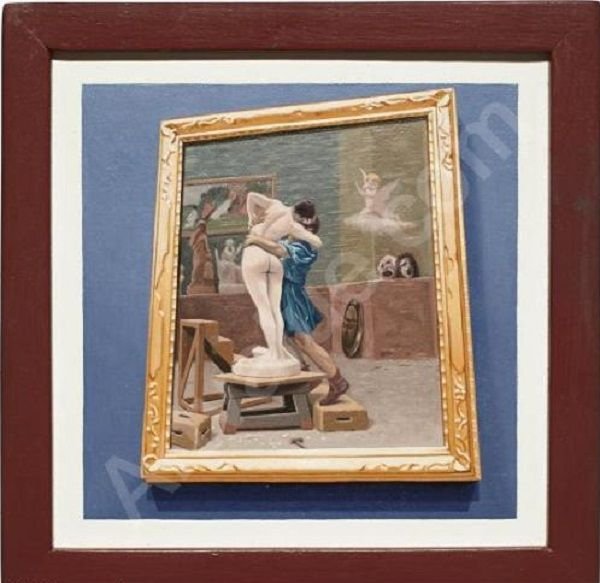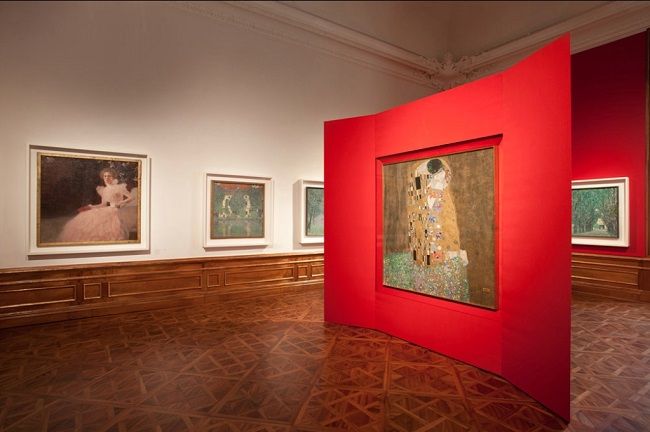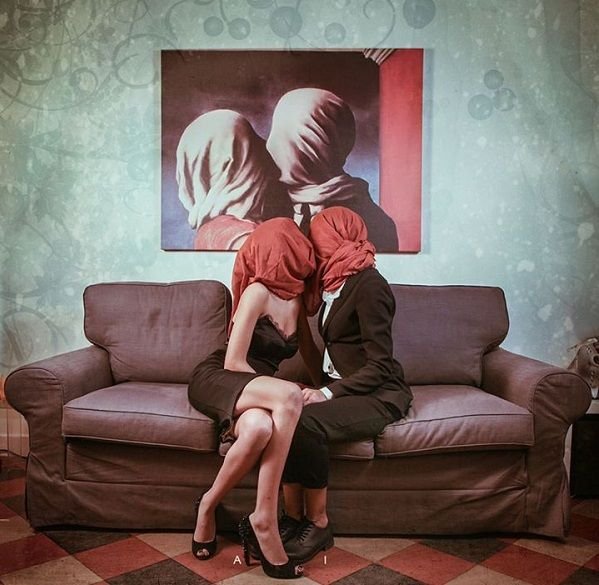The Lovers in the art history
Gentle, irritating, greedy embrace. Artists have always loved to depict those wild scenes of passionate desire in their works that capture the effects of love, blot the mind, and melt the body. Whether forged in a sculpture or locked in the flash of photography, lovers are smothered in the history of art. See how the artists of Jean-Honore Fragonar to Gustav Klimt and Nan Gallin reveal the many facets of love - sensual or fierce, monogamous or polyamorous, fleeting or eternal.

Jean-Honore Fragonard, "The Bolt"
Jean-Honore Fragonar (1732-1806) is a French artist. He is one of the most famous late-born representatives of the Rococo style. Paintings - "The game of blind grandmother", "Musical competition", "Rinaldo in the gardens of Armed", "The Swing", "The Love Letter", "The Reading Woman", "The Stolen Kiss", "Reading". his master Buche and the Italian Renaissance art, and in his later works the influence of Classicalism is also known, in genre his art is varied, he portraits, landscapes, mythological and allegorical compositions, worked on various illustrations and graphics, but to us have not reached a large number of its etchings. Fragonar loves the sexual hints in his lustful paintings. In The Bolt, we see a Cherubian man pulling the lock on the bedroom door while embracing his shy mistress - a look like Maria Antoinette with scarlet cheeks. Through the combination of exquisite rococo (bulging dresses, satin sheets, fresh flowers) and stunning symbolism, the artist gives a clear sign of what should happen. The vase embody the phallus and the vagina, and the upside-down chair with legs upwards reminds her delicately but eloquently of the hero's urge for a more acrobatic performance in the bedroom.

Jean-Leon Gerome, "Pygmalion and Galatea"
Pygmalion et Galatée - a picture of the French artist Jean-Leon Gerome, written by him in 1890. Jerome received a decent academic education and acquired significant connections in the art world, including including Paul Delaroche, Charles Gleir and Theophile Gauthier. Using success in the field of state orders, he gradually inclined towards orientalism, and also engaged in sculpture. In this picture, Jerome turned to the classic myth of Pygmalion and Galatea, the master of stone carving and the sculpture girl he created, which, at his request, was revived by the goddess Venus. The work captures the moment when Pygmalion realized that Galatea came to life, and they merge into a kiss. Before writing the picture, Jerome sculpted from plaster and wove from marble several compositions with this story, repeatedly repeated by him in different interpretations in painting and sculpture. After going through several private collections, now the picture is exhibited at the Metropolitan Museum in New York. In this work, Jerome takes on the ancient Greek myth for a seemingly impossible love. But with little help from the gods, everything is possible, shows us the French master of painting. The story is about the sculptor Pygmalion, who fell in love with a female statue created by him and asked Aphrodite to revive her. The goddess breathed life into the cold ivory figure - in the picture this happens through her messenger - the little happy Cupid. So Pygmalion married her and they both gave birth to Paphos.

Gustav Klimt, The Kiss, 1907
"The Kiss" painting is painted shortly after Klimt finishes his three frescoes on the ceiling of the University of Vienna for which he scandals and is criticized as "pornography" and "perverse incongruity." These works capture the artist's glory of L'enfant terrible for his anti-authoritarian and anti-populist views of art. On this occasion, he writes: "If you can not satisfy everyone with your works and art, try to satisfy just a few" - a quote from Friedrich von Schiller, which Klimt drew on his 1899 painting "Nuda Veritas" the truth "). Unlike the frescoes series, "The Kiss" is enthusiastic and immediately finds a buyer. In this iconic painting of Klimt, lovers are intertwined as if they were in one whole (face to face, locked hands). The famous Austrian symbolist strengthens this physical and emotional intimacy by embracing them with a golden veil. Moreover, the designs of their Art Nouveau-style clothes blend into the waist and wrists, as if their bodies become one. Typical for Klimt's creativity, the realism in the characters' expressions creates the atmosphere of the work: bliss. Some historians believe that the couple is actually Klimt himself and his long-time partner and muse Emily Floye - the last man he calls before his death in 1918.

René Magritte, "Les Amants" 1928
"The super real is the reality that is not separated from its mystery." Hence the poetic flash that fills the paintings of René Magritt. Half a century ago, the Belgian surrealist was celebrated everywhere in the world. Magritte is able to visualize the deep, complex internal affairs of the human mind and its connection to the questions of the heart. The themes of love disappointments and other grim love stories of obsession and idolatry often sneak into the creativity of the master of surrealism. Perhaps nowhere else we see them more powerfully visualized than in "The Lovers" - two people who want each other so much that their impulse - or perhaps their inability to have it entirely - suffocates them, a testimony of which the veils that cover their faces.

Auguste Rodin, The Kiss, 1929
The most famous sculpture of the French master Auguste Rodin is "The Kiss"" (for those who are devoted not to romance but to contemplation, the most famous is the Thinker). The Kiss is made of white marble and its original name is Francesca de Rimini. The two kissing lovers are characters from Dante's Divine Comedy. Francesca was a lady who lived in the thirteenth century, who was married to Giovanni Malatesta, and fell in love with her husband's brother, Paolo. The two fell in love as they read together the story of Lancelot and Guinevere. Giovanni killed both after revealing their affair. Not everyone notices that with his left hand Paolo holds a book. The lovers have not touched their marble lips, which is a hint of Rodin that they have been killed without having sinned. The kiss was presented at the World Exhibition in Paris in 1889. In 1893 a replica of the sculpture was sent to the Chicago World Exposition, but it was judged unacceptable for display along with the other exhibits and was moved to a separate small room where not everyone could enter. Rodin's famous marble sculpture is a world icon of passion. The two figures are literally attached to the mouth, and the thighs seem to melt into each other. The story behind this sculpture is a bit more complicated than that of another ordinary meeting. The man and the woman are inspired by Paolo and Francesca, Dante's "Divine Comedy" characters. Although both were married to others, they were tempted to share this forbidden kiss. Rodin captures the brilliant moment just before Francesca's husband to reveal the fleeting affair and kill both of them.

Leonor Fini, "Les Baigneuses"
In 1996, Leonard Finny died in Paris, 89, surrounded by her two lovers and seventeen Persian cats. Throughout her life, she lived with at least two men at the same time, with countless cats, and always claimed she was born so she would not be like the others. And she never was. They call her "the female Dali," "the Parisian Fria Calo," and also "the most underestimated artist of the XX century". Leonor Fini was one of the most famous figures of surrealism in Paris, but today her name is forgotten. A leading lady in surrealism, proud of her bisexuality and prominent preacher of the polyamory. Her beliefs are often manifested in her misty paintings of powerful women who enjoy in all ways. Although Fini is officially named the first woman to have an erotic naked male figure, her feminine lovers are more common in her work. As in Les Baigneuses, Fini portrays how delicately they cuddle each other and stare at their half-bodies.

Nan Gallin, Rise and Monty Kissing
Unknown - yes, but not nameless. Nan Goldin specifically titled his photos similar to the inscriptions in a family album: "Antony and the Sea" (Brighton, England, 1979), "David on the Train" (Cologne, Germany, 1993), "Kee in the Bed" ) ... Only a few images are enough to begin to perceive the video shot as a home video, in which the frames of the fate of certain people start confronting us. Although we do not know them personally (or are completely strangers), they brutally "invade" our own lives. Although the images appear to be completely ephemeral and unimportant, they attract a lot of attention to penetrate into our stunted memory. At this point, we begin, whether we want it or not, to make a subconscious recapitulation of our own lives and to weigh the guilt that society brings to the individual loner. At first glance, the photographs of Nan Gallin have sealed a micro-society, but in fact, they have an entire world. They show some of the people in the second half of the twentieth century, a time when so-called marginal social groups begin to slip out of the underground and gradually penetrate into the everyday lives of "normal" people. The work "Rise and Monty Kissing" is part of the Gold's The Ballad of Sexual Dependency, a hypnotic and sometimes devastating series of photographs taken in the 1970s, 1980s and 1990s. The series follows extreme extremes and falls in love and sex, lived in the subcultures of New York, Berlin and Boston during Reagan. In this photo, Goldin catches his friends Rice and Monty while they are thirsty, pulling one another's hair. The beer cane in the background hints at the alcoholic and narcotic trance, which is regularly present in the twilight scenes shot through Goldin's lens.
The moment I have read the Rococo art movement, it reminded me of some things I learned about Art in high school. I searched about it and found something interesting.
No wonder it is called that way because of the characteristics present on this art movement.
Interesting information, gaibelga. Thank you :)
I have also learned a lot from you since i started steemit. <3
Beautiful art work! Upovted, followed you, take a look my work as well. Happy New Year! Best wishes from Australia :)

Thank you :)
Wow! so interesting post, exciting!
thanks :)
El mundo del arte es apasionante tantas cosas por aprender y descubrir
True :)